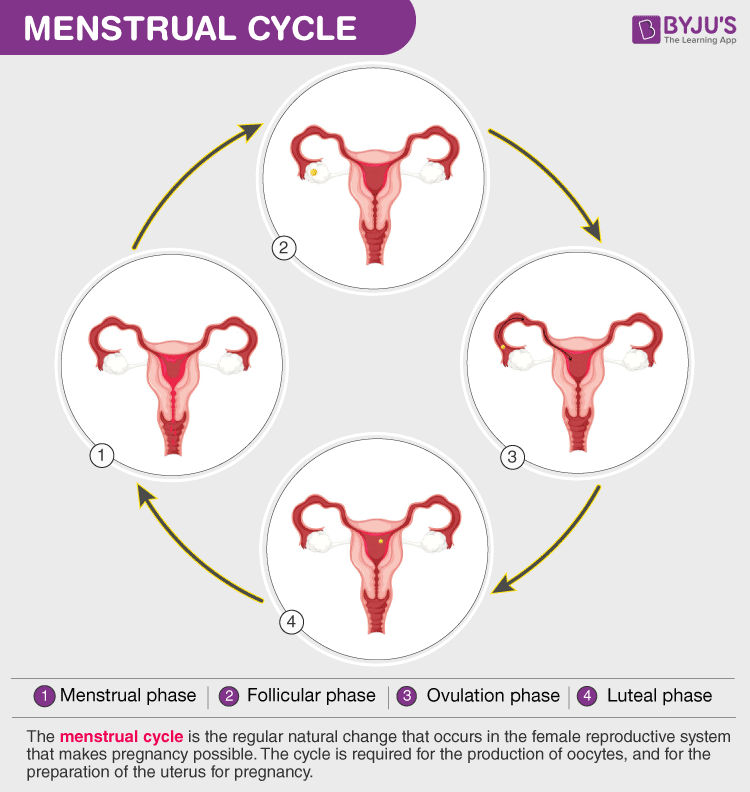Menstruation – DefinitionPhases of Menstrual CycleMenstrual Cycle DiagramRole of Hormones in Menstrual CycleFrequently Asked Questions
Menstruation – Defintion
In a life cycle, a woman’s body is vulnerable to a variety of changes. The cycle of these changes occur in women every month, positively for pregnancy is called the menstrual cycle. When an ovum is unfertilized, the uterus lining sheds and leads to a haemorrhage, called menstruation.

In a girl, menstruation starts from the age of 10 to 15 when she attains puberty and this beginning is known as menarche. The ending of menstruation is known as menopause which takes place at the age range of 50.
The first day of bleeding is marked as the first day of a menstrual cycle and the period from one menstrual cycle to another can vary from 28 to 30 days.
Before discussing the different phases of the menstrual cycle, it is important to have a glimpse of the female reproductive system and organs involved in this cycle. They mainly include:
- A pair of ovaries that store, nourish and release ova.
- Uterus (womb), where implantation of a fertilised egg takes place and the foetus develops.
- Pair of the fallopian tubes connecting the ovaries and uterus.
The count of the ovum in each ovary is decided and fixed before the birth of a girl. As she reaches puberty, hormones stimulate the development and release of one ovum per month. This continues till menopause.
Phases of the Menstrual Cycle
The menstrual cycle is divided into four phases, namely:
- Menstrual phase: Day 1, uterus lining which is prepared for implantation starts to shed which lasts 3 to 5 days.
- Follicular phase: In this phase, the primary follicle starts developing into a mature Graffian follicle. The endometrium also starts proliferating. The uterus starts preparation for another pregnancy.
- Ovulatory phase: Mid-cycle phase, this is the phase in which ovulation takes place i.e., day 13-17. The end of the follicular phase along with the ovulation period defines the fertilisation period.
- Luteal phase: It is the post-ovulation phase, where the fate of the corpus luteum is decided. If fertilisation occurs, pregnancy starts. If fertilisation doesn’t occur, it marks the onset of another cycle.
Menstrual Cycle Diagram
Role of Hormones in Menstrual Cycle
The chemical messengers in our body called hormones, released by various endocrine glands are responsible for many changes in a human body. Menstruation is a slave to certain hormones. Every phase of the menstrual cycle is influenced by a female hormones namely estrogen, progesterone, FSH and LH. The variation in the level of each of these hormones decides the phase which a girl undergoes.
Let’s have a look at the role of hormones in the menstrual cycle with the help of a diagram.

Follicle-stimulating hormone (FSH) and luteinizing hormone (LH) are secreted by the anterior pituitary. FSH stimulates the growth of ovarian follicles that secrete estrogen. Progesterone is secreted by the corpus luteum.
As we can see in the above diagram, the secretion of FSH and LH gradually increases during the follicular phase. They stimulate the development of follicles and the release of estrogen from them. Estrogen stimulates the proliferation of the endometrium. The level of LH and FSH peaks in the middle of the cycle. LH induces ovulation. There is a sudden surge in LH level just before ovulation. After ovulation, the ruptured follicle develops into the corpus luteum, which secretes progesterone, hence the level of progesterone increases in the luteal phase. Progesterone is required for the maintenance of the endometrium for implantation. In the absence of fertilisation, corpus luteum regresses and progesterone level decreases. It leads to the disintegration of the endometrium and menstrual flow occurs.
Also Check:
| Oogenesis |
| Difference between Estrogen and Progesterone |
| Difference between Corpus Luteum and Corpus Albicans |
We had an overview of the menstrual cycle. For detailed information, download BYJU’S-The Learning App.
Frequently Asked Questions
What is the duration of a menstrual cycle?
The duration of a menstrual cycle is usually 28 days. But, under different physiological conditions, it may vary anywhere between 20 and 40 days.
What is ovulation?
Ovulation is a process by which the Graafian follicle ruptures with the consequent discharge of the ovum into abdominal cavity. This phase is primarily influenced by the luteinizing hormone. It occurs on the 14th day of menstrual cycle in a normal cycle of 28 days. During this process, the ovum enters the fallopian tube.
What is corpus luteum?
Corpus luteum is a glandular yellow body developed from the ruptured Graafian follicle after the release of the ovum.


Very educative article
This was very nice, Helped me in my exam
Very Useful and clear explanation.
Thank you very much
I like this
Thanks for your explanation
Thanks for information about class